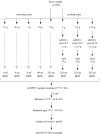A modelling approach to estimate the sensitivity of pooled faecal samples for isolation of Salmonella in pigs
- PMID: 16849194
- PMCID: PMC1578272
- DOI: 10.1098/rsif.2005.0057
A modelling approach to estimate the sensitivity of pooled faecal samples for isolation of Salmonella in pigs
Abstract
The objective of this study was to develop and parametrize a mathematical model of the sensitivity of pooled sampling of faeces to detect Salmonella infection in pigs. A mathematical model was developed to represent the effect of pooling on the probability of Salmonella isolation. Parameters for the model were estimated using data obtained by collecting 50 faecal samples from each of two pig farms. Each sample was tested for Salmonella at individual sample weights of 0.1, 0.5, 1, 10 and 25 g and pools of 5, 10 and 20 samples were created from the individual samples. The highest test sensitivity for individual samples was found at 10 g (90% sensitivity), with the 25 g test sensitivity equal to 83%. For samples of less than 10 g, sensitivity was found to reduce with sample weight. Incubation for 48 h was found to produce a more sensitive test than incubation for 24 h. Model results found increasing sensitivity with more samples in the pool, with the pools of 5, 10 and 20 being more sensitive than individual sampling, and the pools of 20 being the most sensitive of those considered.
Figures



Similar articles
-
Estimation of sample sizes for pooled faecal sampling for detection of Salmonella in pigs.Epidemiol Infect. 2009 Dec;137(12):1734-41. doi: 10.1017/S0950268809002702. Epub 2009 May 6. Epidemiol Infect. 2009. PMID: 19416556
-
Bayesian zero-inflated predictive modelling of herd-level Salmonella prevalence for risk-based surveillance.Zoonoses Public Health. 2010 Nov;57 Suppl 1:60-70. doi: 10.1111/j.1863-2378.2010.01355.x. Zoonoses Public Health. 2010. PMID: 21083819
-
Comparison of bacterial culture and real-time PCR for the detection of Salmonella in grow-finish pigs in Western Canada using a Bayesian approach.Zoonoses Public Health. 2010 Nov;57 Suppl 1:115-20. doi: 10.1111/j.1863-2378.2010.01365.x. Zoonoses Public Health. 2010. PMID: 21083825
-
Toward standardization of diagnostic PCR testing of fecal samples: lessons from the detection of salmonellae in pigs.J Clin Microbiol. 2005 Jul;43(7):3033-7. doi: 10.1128/JCM.43.7.3033-3037.2005. J Clin Microbiol. 2005. PMID: 16000411 Free PMC article. Review. No abstract available.
-
Designing serological surveillance programmes to document freedom from disease with special reference to exotic viral diseases of pigs in Denmark.Rev Sci Tech. 2000 Dec;19(3):715-24. doi: 10.20506/rst.19.3.1247. Rev Sci Tech. 2000. PMID: 11107614 Review.
Cited by
-
Recovery of Salmonella bacterial isolates from pooled fecal samples from horses.J Vet Intern Med. 2023 Jan;37(1):323-327. doi: 10.1111/jvim.16586. Epub 2022 Nov 25. J Vet Intern Med. 2023. PMID: 36433697 Free PMC article.
-
Critical Analysis of Pork QMRA Focusing on Slaughterhouses: Lessons from the Past and Future Trends.Foods. 2020 Nov 20;9(11):1704. doi: 10.3390/foods9111704. Foods. 2020. PMID: 33233782 Free PMC article. Review.
-
Evaluation of the pooling of swabs for real-time PCR detection of low titre shedding of low pathogenicity avian influenza in turkeys.Epidemiol Infect. 2013 Jun;141(6):1286-97. doi: 10.1017/S0950268812001811. Epub 2012 Sep 3. Epidemiol Infect. 2013. PMID: 22939242 Free PMC article.
-
Prevalence and risk factors for bacterial food-borne zoonotic hazards in slaughter pigs: a review.Zoonoses Public Health. 2009 Oct;56(8):429-54. doi: 10.1111/j.1863-2378.2008.01185.x. Epub 2009 Jan 17. Zoonoses Public Health. 2009. PMID: 19175574 Free PMC article. Review.
-
Evaluation of the sensitivity of faecal sampling for detection of monophasic Salmonella Typhimurium and other Salmonella in cattle and pigs.Epidemiol Infect. 2015 Jun;143(8):1681-91. doi: 10.1017/S0950268814002453. Epub 2014 Sep 30. Epidemiol Infect. 2015. PMID: 25266772 Free PMC article.
References
-
- Abel U, Schosser R, Suss J. Estimating the prevalence of infectious agents using pooled samples: biometrical considerations. Zentralbl. Bakteriol. 1999;289:550–563. - PubMed
-
- Anon . The Stationery Office; London: 2000. A report of the study of infectious intestinal disease in England.
-
- Anon . Defra; London: 2004. Zoonoses Report United Kingdom 2003.
-
- Armstrong D. Food safety in the British pigmeat production and marketing chain. The Pig J. 2001;47:88–97.
-
- British Pig Executive. Meat & Livestock Commission; Milton Keynes, UK: 2003. ZAP Salmonella update.
Publication types
MeSH terms
LinkOut - more resources
Full Text Sources
Medical

